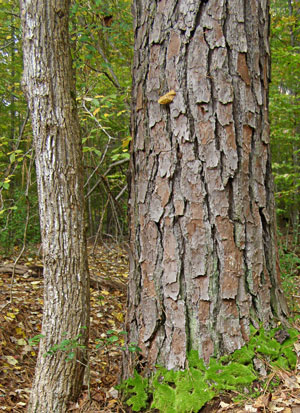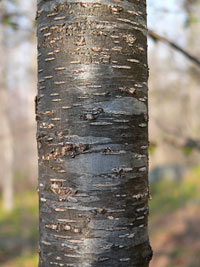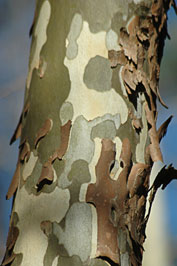Winter tree watch
By Ken Moore
Flora Columnist
I hope some of you joined in on the Eno River Association New Year’s Day Hike. That annual tradition began more than 40 years ago.
More recently, 20 years ago, the Blue Hill Reservation, a state park in Milton, Mass., initiated First Day hikes for the American State Parks system. This year for the first time, state parks in all 50 states sponsored First Day hikes. We can be proud that 27 of North Carolina’s state parks joined the Eno River Association in conducting a New Year’s Day hike.

The unmistakable bark of loblolly pine (right) contrasts with the rough grey bark of the elm on the left. Photo by Ken Moore
Now don’t stop with that “first hike.†Resolve to take a walk at least once a week. If you need encouragement, make note that the Eno River Association has scheduled Sunday walks (enoriver.org) from now through spring.
I think the winter season is the best time to be outside, when the bareness and sparseness of nature reveals the essence and beauty of it all. There’s so much to see and absorb in the winter landscape that it can be overwhelming. I enjoy focusing on the trees. Think of it as a winter tree watch.
Walk some distance into the forest and pause. Look all around; unless you’re in a stand of evergreen pines, you may feel a slight panic, lost in a wilderness of grey monotony. Close your eyes and slowly open them to take a closer look all around.
Trees reveal all kinds of interesting traits when they are leafless. For this particular walk, just focus on bark, the protective skin of the trees. Some, like the pines, are easy to detect; we’ll take time to distinguish between our three locally common pines in a couple of weeks.
For now, concentrate on variations of bark on the other trees. Is the bark smooth, and if so, is it colored or rippled like a muscular arm? If the bark is rough, you have a whole world to explore. Is the bark peeling away from the tree in distinctive patterns? Is the bark deeply grooved (furrowed), and are those groves vertical, sometimes making diamond shapes, or crisscrossed with horizontal cuts making square or angular patterns?
Don’t be concerned with names of all these different trees. It’s as if you’re at a holiday gathering of mostly new people. There are way too many new names to remember. Just enjoy meeting new personalities. If you are inclined, begin keeping a nature journal of sketches of bark patterns, or begin a digital photo collection. Either or both can come in handy later. If you sketch, I promise you’ll never forget what you’re seeing.
And now, as you continue your walk, notice how some trees may disappear or appear around you as you change your position from low ground to high ground, from sunny south slopes to darker north slopes. You’re observing that some trees can be mighty particular about the ground upon which they stand.
Well now, that’s enough for today’s walk. Enjoy the new nameless friends you’ve just made, and with whom you’ll be getting better acquainted on subsequent walks.
Email Ken Moore at flora@carrborocitizen.com. Find previous Ken Moore Citizen columns at The Annotated Flora.




Comments are closed.